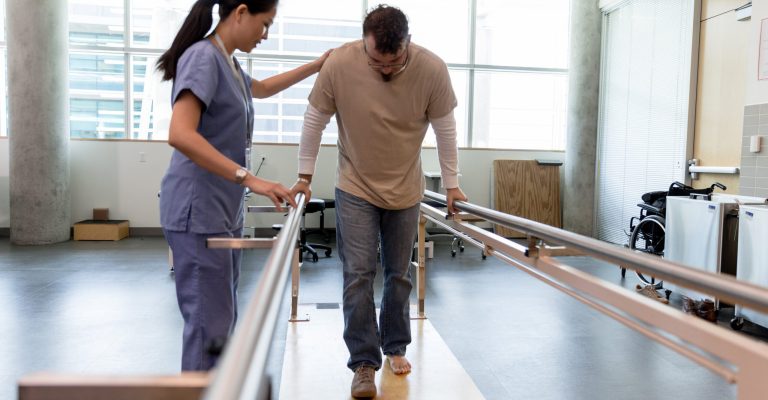
A stroke is a disorder that may be life-threatening and affects millions of individuals all over the globe. One of the most typical aftereffects of having a stroke is experiencing weakness or paralysis in the limbs below the waist. Stroke sufferers may find it difficult to conduct even the most fundamental activities due to this, such as walking or climbing stairs. The patient’s strength, flexibility, and mobility may all be improved by undergoing physical therapy, which is a vital component of rehabilitation after a stroke.
Leg exercises for stroke patients because they may assist in enhancing the function of the lower limbs, which are often impaired after a stroke. In this piece, we will talk about various leg exercises for stroke patients that may be useful and helpful in getting them to walk again after having a stroke.

This exercise promotes flexibility in the ankle and foot, which in turn contributes to improving circulation. The patient should either sit or lay down in a comfortable posture, then raise their foot up and down many times while continuing to repeat the exercise. When doing this exercise, it is essential for the patient to place their whole concentration on tensing the muscles in their feet and ankles.
Flexibility in the knees and hips may be improved with the aid of this exercise. The patient has to be positioned such that they are lying on their back with their knees bent and their feet completely flat on the ground. After that, they should repeat the motion numerous times, sliding their heel in the direction of their buttocks as slowly as possible. During this particular exercise, the patient should concentrate on keeping the muscles in their thighs as relaxed as possible.
Strength in the thigh muscles may be improved with the aid of this particular workout. The patient should lay on their back with their legs straight, then pull one leg up towards the ceiling numerous times while continuing to repeat the activity. When the patient lifts their leg, they should concentrate on tightening the muscles in their thighs and maintain that tension for several seconds before releasing it and lowering their leg again.
The flexibility of the hip and thigh muscles is improved as a result of doing this exercise. While lying on their back, the patient should pull one knee up to their chest and maintain the posture for a few seconds before releasing it and returning it to its initial position. During this exercise, the patient should place their primary concentration on maintaining a pushed-against-the-floor position for their lower back.
This exercise serves to enhance both balance and leg muscular strength, making it a useful addition to any workout routine. Using a step or a low bench, the patient has to step up and down with each foot, doing the exercise many times. This should be done numerous times. When the patient is stepping up and down, the patient should concentrate on maintaining their knee above their ankle.
Strength in the thigh muscles may be improved with the aid of this particular workout. The patient has to get on their back, tense the muscles on the front of their thighs, and hold that contraction for a few seconds before releasing it. After that, they should relax those muscles. During this exercise, the patient should concentrate on maintaining their knee in a straight position at all times.
This is a more difficult version of the strengthening workout. Patients recovering from a stroke who have restricted movement should proceed with care. You could try practicing in front of a table or desk that you can grip for support so that you can reduce the risk to your safety.
To begin, stand in a powerful posture with your legs spread a bit more apart than usual than they normally would be. The next step is to rise up halfway, but not all the way, and then sit back down again. You can have a little stinging sensation in your quadriceps. This indicates that you are weakening your leg muscles in preparation for your body to rebuild them in a more powerful manner than they were previously.
Strength in the muscles of the foot and ankle may be improved with the aid of this exercise. The patient has to be seated in a chair and instructed to alternatively tap each of their toes on the floor. This action needs to be performed many times. The patient should be mindful of maintaining a straight knee while tapping their toes and should make an effort to contract the muscles in their ankles and feet while they carry out this activity.
Calf muscles may be made more powerful with the aid of this particular workout. The individual being treated should stand with their feet spaced hip-width apart, then lift their heels off the ground and repeat the exercise many times. When the patient raises their heels, they should concentrate on tightening the muscles in their calves and should maintain that tension for a few seconds before releasing it and lowering their heels again.
The patient’s coordination and balance will benefit from the activity that you have them do. Before shifting their weight to their other foot, the patient should first stand on one foot and maintain that posture for a few seconds. To increase the difficulty of the exercise and to provide the patient with a new challenge, they may attempt standing on an unstable surface such as a balancing board or foam pad.
It is important to note that these leg exercises for stroke patients should only be done under the guidance of a physical therapist and that the intensity and frequency of the exercises should be tailored to the individual patient’s needs and abilities. In addition, it is essential to pay attention to the patient’s degree of pain and discomfort and make appropriate modifications to the exercises based on this information.

These leg exercises for stroke patients may be extremely useful. These exercises can assist in enhancing the patient’s strength, flexibility, coordination, balance, and mobility in the lower limbs.
These exercises should be carried out under the supervision of a physical therapist, and the level of difficulty and the number of repetitions should be modified according to the specific requirements and capabilities of the particular patient. Patients who have had a stroke may improve their quality of life and recover their independence with the assistance of a physical therapist and by engaging in regular physical activity.